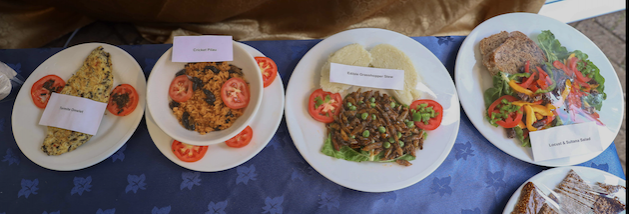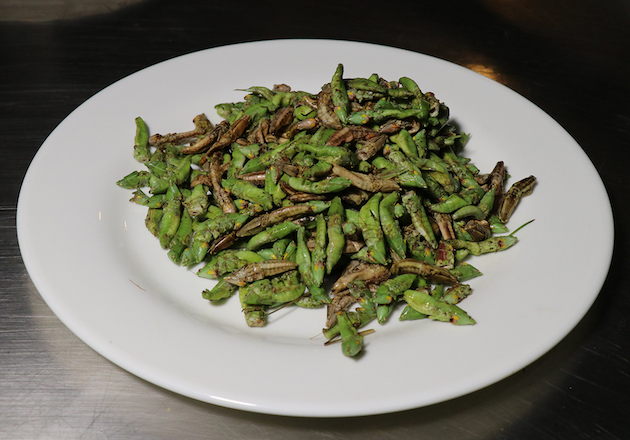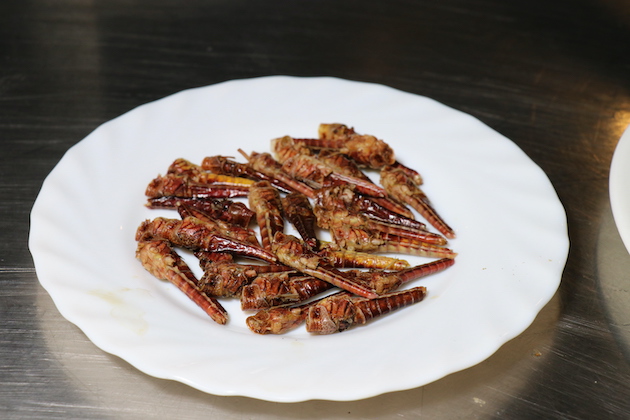Give Edible Insects a Chance as an Alternative High-Quality Protein Source, say Scientists

Nairobi, May 06 (IPS) - Growing up in Samoya Village of Bungoma County in the Western part of Kenya, Elvis Wanjala has fond childhood memories of the rainy season, chasing and catching black-bellied winged termites in the rain.
“The termites would also come inside the house, attracted by the light late in the evening. My mother would sun-dry the termites and pan-fry them. We would then eat the crunchy termites with ugali (posho) and a serving of traditional vegetables,” he recounts.
“I grew up believing that everybody ate termites. At 11 years, I visited my uncle in Nairobi and was shocked to find that termites were more of a nuisance than food. One morning after a heavy downpour, I watched in awe as women and girls swept termites from their doorsteps and threw them in the bin.”
Beatrice Karare from the Ministry of Agriculture, Livestock and Fisheries tells IPS termites, and other insects such as grasshoppers, locusts, black and white ants, and crickets are part of traditional diets in Western Kenya, but not so in other parts of the country.
But with rising inflation, scientists at the International Centre of Insect Physiology and Ecology (icipe) say edible insects are a low-cost alternative to more expensive foods. The Kenyan ‘food basket’ indicates that food inflation rose by 20 percent in January 2022 compared to the same period in 2021.

Dr Saliou Niassy, a scientist from icipe, tells IPS edible insects contain high-quality protein, vitamins, fibre, calcium, iron, B vitamins, selenium, zinc, and amino acids and are also an excellent source of healthy fats.
Insect oil produced through an icipe research project from two edible insects – the desert locust and the African bush-cricket – was richer in omega-3 fatty acids, flavonoids, and Vitamin E than the plant oil.
Niassy says as this East African nation grapples with increasing threats to food security such as “climate change, landscape degradation and pest invasion, edible insects are a viable and affordable alternative.” It is projected that Africa’s annual food import bill of $35 billion could rise to $110 billion by 2025.
A survey conducted by icipe shows there are an estimated 500 species of edible insects in African communities. The Central African region is home to approximately 256 edible insect species. East Africa hosts about 100 species, and about eight species are available in North Africa. An estimated 17 primary species are used for feed and food in Kenya.
“We have had two main challenges as far as increasing consumption of insects is concerned, a lack of legislation around the production, packaging, and marketing of insects for food and strong perceptions that dictate what is culturally acceptable as food. There are also strong beliefs that you must be very poor to eat insects,” Karare explains.
Karare says some of these issues were resolved in December 2020 when Kenya became the first African country to develop national standards regulating the production, handling, and processing of insects for food and feed.
Included in the regulation are stipulations of the necessary minimum infrastructural and environmental requirements necessary for the ideal production of edible insects, including how they are packaged and presented.
Wanjala, now a teacher based in Nairobi, says communities that do not eat insects and children could be slowly introduced to insect products such as biscuits “so that the idea of eating insects can slowly sink in. When it comes to eating whole insects, I find that people are also more likely to try dry-fried, crunchy insects.”
Despite the challenges of creating a viable and attractive market for insects, Karare is convinced that insects can be part of the diet in many homes, drawing parallels with the journey of Kenyans embracing traditional vegetables.
“A few years ago, highly nutritious traditional vegetables were eaten by a few communities. In Central Kenya, for instance, Amaranthus was considered to be food for poor people. Today, Amaranthus is a popular delicacy and part of the menu in five-star hotels. The same with pumpkin leaves,” Karare observes.
“We need to educate the people that edible insects can add nutrients to a plant-based meal. More importantly, insects can even nutritionally replace meat.”

According to the UN’s Food and Agriculture Organization (FAO), an estimated 2.5 billion people eat insects as part of their regular meals, whole or in processed food products such as snacks and pasta. Karare says the global edible insect market estimated at $112 million in 2019, could reach $1.5 billion by 2026.
There are approximately 1,900 edible species globally, including butterflies, cockroaches, crickets, grasshoppers, ants, bees, dragonflies, beetles, domestic silk moths, centipedes and locusts.
According to FAO, turning to insects is not only good for the body but highly environment friendly and could contribute to reducing the emission of harmful greenhouse gases. The livestock sector contributes significantly to climate change as total emissions from global livestock represent 14.5 percent of all anthropogenic greenhouse gas emissions.
Cattle reared for beef and milk and inedible outputs such as manure and draft power account for 65 percent of the livestock sector’s emissions. Producing insects for food is yet another alternative to reducing the emission of harmful greenhouse gases, the FAO says.
Crickets need six times less feed than cattle, four times less than sheep, and half as much as pigs and broiler chickens to produce the same amount of protein. Additionally, insect-based products are found to have a much smaller carbon footprint in comparison to conventional livestock.
With these revelations, Niassy says there is a lot more to learn and benefit from, “we have just scratched the surface in terms of sustainable access to biodiversity for resilience, livelihood, food and nutritional security in Africa.”
IPS UN Bureau Report
Follow @IPSNewsUNBureau
Follow IPS News UN Bureau on Instagram
© Inter Press Service (2022) — All Rights Reserved. Original source: Inter Press Service
 Global Issues
Global Issues